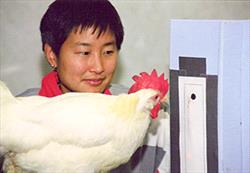Dr. Sophia Yin, DVM, CAAB, MS was a veterinarian, animal behaviorist, author, and the creator of Low Stress Handling®.
Through scientific methods, rigorous research and testing, she created the techniques which are the foundations of Low Stress Handling® and are the origins for many modern animal behavior and training programs. To this day, her methodology has been used in schools and clinics all around the world and her teachings have shaped the new standard of care for veterinary professionals, pet professionals, shelter workers, and pet owners. Dr. Yin passed away in September of 2014, but through CattleDog Publishing and VIN, the Veterinary Information Network, her work and legacy lives on.
Dr. Yin knew from personal experience the hardship of having a reactive, anxious pet and no resources for professional help. She saw around her the many shattered relationships between misunderstood pets and their frustrated human companions. As a result, her mission became a desire to understand animals and their behavior so that the rest of us could care for, appreciate, and enjoy our time with them harmoniously.
Sophia learned that every pet needs a human who can lead, not like a boss but like a partner in a dance. A pet needs a teacher who gives clear signals, rewards desirable behaviors, removes rewards for inappropriate ones, and trains predictably and consistently. She realized that since animals do not understand the spoken word, they rely on reading body language to adjust their own behaviors. Humans then must be aware of their own movement and actions because every move influences the animal’s behavior and perception.
Her hands-on experience was as extensive as her education. Dr. Yin worked at San Francisco Veterinary Specialists, wrote for veterinary and popular magazines, and consulted for many zoos. In addition, she also lectured, taught workshops internationally on animal behavior and Low Stress Handling®, and was a behavior expert for shows such as Dogs 101 on Animal Planet. She served on the executive board for the American Veterinary Society of Animal Behavior, the American Association of Feline Practitioners (AAFP) Handling Guidelines Committee, and the American Humane Association (AHA) Animal Behavior and Training Advisory Committee. Dr. Yin was a respected author and creator of multiple educational resources that addressed animal care, handling, and training.
Why Sophia Chose the Behavior Field
Like most of her colleagues, she knew from a young age that she wanted to be a veterinarian. Sophia worked in kennels, veterinary hospitals, any animal experience she could. She majored in one of the most rigorous college science majors: biochemistry. In 1993, she achieved her dream and graduated from the University of California–Davis School of Veterinary Medicine. Dr. Yin then started in private practice as a veterinarian.
Over time, she noticed more patients had behavior concerns than medical ones. Because of previous experience with her own dog, she made it a priority to discuss potentially serious behavioral issues and to counsel those who wanted help. The problems were too involved to address during a regular office visit with the basic dog training skills she knew, so Sophia returned to school to learn more about behavior.
A Well-Rounded Approach
To specialize in behavior, veterinarians can follow a two- to three-year clinical residency conducting behavior consults and clinical research. Instead they may instead pursue a Master’s Degree or Ph.D. by completing courses and performing research to fulfill requirements set by the Animal Behavior Society, and gain clinical experience.
Sophia’s chosen path combined animal behavior experiences with a Master’s in Animal Science at UC Davis under Dr. Edward Price. During that time, she researched barking in dogs, passed her behavior courses, conducted numerous animal behavior projects, participated in lectures, and was a teaching assistant in biochemistry.
Traditional Force Training vs. Leadership Without Force
In Dr. Sophia’s Own Words:
“We’ve all heard the old school advice relating dog behavior to wolf social behavior: Show your dog you are the boss, the alpha. Twenty years ago when I started training, that was the advice I gave because it was all I knew. Like everyone else, the choke chain, pinch collar and a well-timed correction formed the cornerstone of dog training for me. I thought that dominance was the root of all behavior problems. Combined with a strong ability to read aggressive dogs, a lack of fear of being bitten, and fervor for trying to master the techniques of whomever I could, these methods and ideologies served me well. They were the methods of the traditional dog trainer, now sometimes called a balanced dog trainer if rewards are sometimes used.
Because I am always searching for ways to improve, as knowledge of dog and wolf behavior trickled down from the research and field scientists, my knowledge of animal behavior expanded and consequently my philosophies changed.
In the past two decades, our understanding of dog behavior in relation to wolves, as well as our understanding of dominance and social hierarchies has advanced. Wolf biologists now rarely use the term alpha when referring to pack leaders in the wild. Careful observation has revealed that dominant wolves do not force subordinates onto their back (incorrectly termed an alpha roll). Rather subordinates offer the posture as a sign of deference (more appropriate term, submissive roll). In addition, ethologists agree that studies on the process of domestication and on canine communication are making it more and more clear that a dog is not a wolf.”
Dominance is Not the Root of Bad Behavior
It is also now clear that dominance is generally not the cause of bad behavior and is evident once you know the definition of dominance. In animal behavior, dominance is defined as a relationship between individuals that is established by force, aggression and submission in order to gain priority access to resources. A dominance relationship is not established until one individual consistently submits. With this definition in mind, it is clear that most of the unruly behaviors we see in our pets are not due to a desire to gain higher rank. Consequently, dominance theory becomes irrelevant for most behavior problems in our pets.
Leadership Without Force
Studies on learning and behavior of the last 60+ years have shown us that animals (and humans) behave in undesirable ways because these behaviors have been reinforced. To change behavior, we have to remove the rewards for undesirable behavior and instead reward good behavior.
That simple approach, along with attention to timing, body language, and motivation, forms the basis for establishing a relationship of trust between the human and the pet. Training becomes a joy rather than a chore and the methods open up a whole new connection with your pet.
A Better Way of Training
The newer approach to training considers the animal’s motivations for learning, their comprehension, and the incremental steps for learning. The philosophy is simple and direct.
Keys to Modifying Behavior
Modification is surprisingly simple and easy at least for the pet. Animals do what is rewarding to them. We can change their behavior by no longer rewarding inappropriate ones and rewarding those which we deem appropriate. The challenge is human involvement because it requires observation and modifying our own habits when pets are around. As a result, we are always communicating so every interaction we have with the pet is a training session.
Learn to Lead – Like a Partner in a Dance
Once we approach behavior modification in this manner, we realize training is like a dance. When partners dance as a couple, one leads and the other follows. The leader decides which steps to perform and then guides his partner clearly so the partner can follow.
Training animals requires an understanding of the big dance and an ability to break the movements down into little steps. Little differences in movement can make big differences in behavior. We convey this to the animal through our body language and perfectly timed rewards. We set rules by rewarding good behaviors and removing rewards for inappropriate behavior. Good behavior will become a habit.
The Use of Punishment and an Animal’s Emotional State
Training also needs to address the underlying emotional state. If an animal is fearful, a leader who “dominates” will not change the emotions.
The use of force in training can cause animals to seem stubborn and willful when they are actually frustrated and confused. They will have little motivation to perform the commanded behaviors other than the desire to avoid fear and pain. Punishment does not take into consideration the motivation of the animal nor does it tell them what they should be doing. Instead, punishment just tells them what they should not be doing.
The purpose of force in most cases is to stop a behavior. Overall, force suppresses behavior only temporarily, especially when the animal is not rewarded for appropriate behaviors, nor does it address the underlying emotional state.
Humans fall back on punishment because it is easier to react in the moment to a problem than to think about how to prevent the problem instead. Instead, be proactive and remove the “punishment” crutch.




